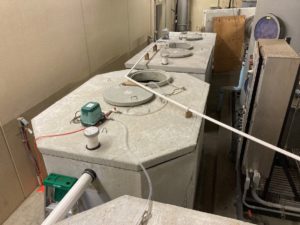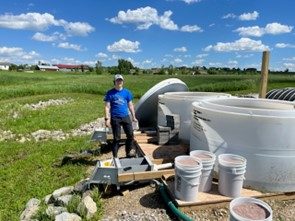nutrient removal projects win student pilot funding
By Laura Mullen, Member Engagement Manager
 The Water Council congratulates the winners of our Future Water Leaders Fund Student Pilot Project!
The Water Council congratulates the winners of our Future Water Leaders Fund Student Pilot Project!
This pilot program assists in funding Wisconsin students’ water-focused pilot demonstration projects and is funded jointly by The Water Council, the Fund for Lake Michigan, the Freshwater Collaborative of Wisconsin and the University of Wisconsin-Milwaukee’s School of Freshwater Sciences. We are thrilled to announce these two winners who will each receive a $5,000 award.
Alexis Countryman, from the Milwaukee School of Engineering, is testing a nitrogen and phosphorus removal device for onsite wastewater treatment systems utilizing microbial inoculator generators (MIG) and nutrient removal. The pilot project was deployed on April 5, 2022, at the Brookfield Wastewater Treatment Plant and is intended to run through November. Water sampling will occur throughout the process and nutrient removal rates will be assessed.
According to Alexis, “The pilot project will examine nitrogen and phosphorus removal of two septic system remediation technologies. The results of the pilot could reduce the impacts of excessive nutrient loading associated with private onsite wastewater treatment.”

Beth Kondro, a student at the University of Wisconsin-Green Bay, received funding for her project testing lanthanum-modified wastewater treatment residuals for removal of phosphorus in cropland runoff. Once deployed at the Heart of the Valley Metropolitan Sewerage District, samples of the inflow and outflow will be collected at each runoff event and analyzed.
Beth says, “The goal of this project is to use a locally sourced waste material to remove dissolved phosphorus from agricultural runoff. The material is drinking water treatment residuals. The residuals will be modified with lanthanum to enhance phosphorus sorption and pelletized to increase mechanical strength before deployment at an active agricultural runoff treatment system.”

Alexis says she appreciates the student pilot program. “The application process was simple and accommodated the potential differences in projects. The two-part application allowed judges to fill in any gaps from my written application and allowed time for questions that benefit my project as a whole. I am extremely grateful to have received the funding associated with this application!”
Beth adds, “In addition to getting hands-on experience with water quality technologies, I’m excited to use my chemistry background to address a water quality challenge in my community.”